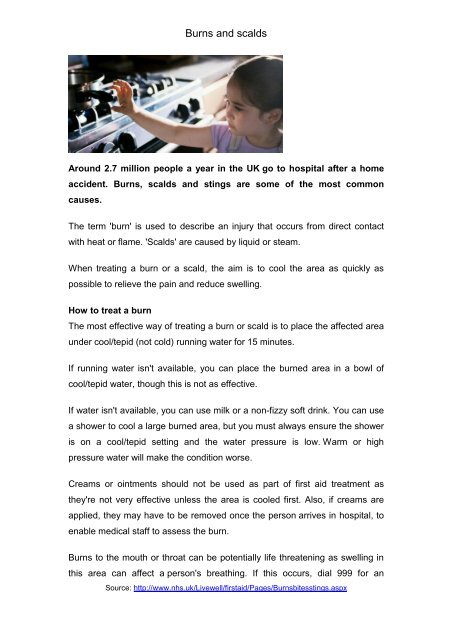Burns and scalds
burns and scalds 2 - Go-Woman!
burns and scalds 2 - Go-Woman!
- No tags were found...
You also want an ePaper? Increase the reach of your titles
YUMPU automatically turns print PDFs into web optimized ePapers that Google loves.
<strong>Burns</strong> <strong>and</strong> <strong>scalds</strong><br />
Around 2.7 million people a year in the UK go to hospital after a home<br />
accident. <strong>Burns</strong>, <strong>scalds</strong> <strong>and</strong> stings are some of the most common<br />
causes.<br />
The term 'burn' is used to describe an injury that occurs from direct contact<br />
with heat or flame. 'Scalds' are caused by liquid or steam.<br />
When treating a burn or a scald, the aim is to cool the area as quickly as<br />
possible to relieve the pain <strong>and</strong> reduce swelling.<br />
How to treat a burn<br />
The most effective way of treating a burn or scald is to place the affected area<br />
under cool/tepid (not cold) running water for 15 minutes.<br />
If running water isn't available, you can place the burned area in a bowl of<br />
cool/tepid water, though this is not as effective.<br />
If water isn't available, you can use milk or a non-fizzy soft drink. You can use<br />
a shower to cool a large burned area, but you must always ensure the shower<br />
is on a cool/tepid setting <strong>and</strong> the water pressure is low. Warm or high<br />
pressure water will make the condition worse.<br />
Creams or ointments should not be used as part of first aid treatment as<br />
they're not very effective unless the area is cooled first. Also, if creams are<br />
applied, they may have to be removed once the person arrives in hospital, to<br />
enable medical staff to assess the burn.<br />
<strong>Burns</strong> to the mouth or throat can be potentially life threatening as swelling in<br />
this area can affect a person's breathing. If this occurs, dial 999 for an<br />
Source: http://www.nhs.uk/Livewell/firstaid/Pages/<strong>Burns</strong>bitesstings.aspx
<strong>Burns</strong> <strong>and</strong> <strong>scalds</strong><br />
ambulance immediately, loosen all clothing around the person’s neck <strong>and</strong> be<br />
prepared to resuscitate.<br />
It is common for swelling to occur following a burn so it's important to remove<br />
any tight clothing before the swelling occurs. However, don't remove any<br />
clothing or material that may be sticking to a burn. It is possible to remove<br />
clothing while the burn is being cooled.<br />
<strong>Burns</strong> to the mouth or throat can be potentially life threatening<br />
Once the area has been cooled, cover the burn with a clean, non-fluffy<br />
material. This will help to prevent the wound becoming infected <strong>and</strong> reduce<br />
the pain.<br />
An alternative dressing for a burn is a clean, unused plastic bag such as a<br />
freezer or s<strong>and</strong>wich bag, or clean kitchen film (clingfilm). A bag is particularly<br />
useful for treating burns to the h<strong>and</strong> <strong>and</strong> lower arm.<br />
Once the bag is placed over the h<strong>and</strong> or arm, secure it in the place using a<br />
plaster or b<strong>and</strong>age. Clingfilm is best for arms or legs. Discard the first piece of<br />
clingfilm as it may be contaminated by human h<strong>and</strong>s or food. Place the clean<br />
piece of cling-film loosely around the burn.<br />
Once the burn is cooled <strong>and</strong> covered, seek medical advice.<br />
Source: http://www.nhs.uk/Livewell/firstaid/Pages/<strong>Burns</strong>bitesstings.aspx



